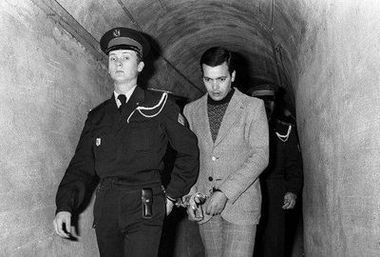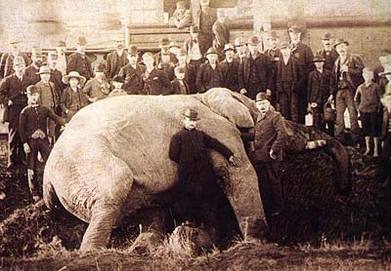
September 10, 1897
 Suspected drink driver blowing into a Drunkometer
Suspected drink driver blowing into a Drunkometer He was fined 25 shillings.
Interestingly enough Smith had admitted that he was drunk when he had his accident. This was fortunate for the police as they really did not have a way of proving Smiths guilt... there were no breathalysers back in those days, well nothing reliable anyways.
It was not until the 1930's when a biochemistry professor invented the 'Drunkometer' that the level of intoxication could be determined with any real accuracy. The suspect would blow into a ordinary balloon afterwhich the inflated balloon was attached to a tube filled with Potassium permanganate and sulphuric acid which would change colour by the alcohol in the suspects breath – the quicker the colour change the more intoxicated they were!
September 10, 1977
 Hamida Djandoubi in custody
Hamida Djandoubi in custody Djandoubi was charged with torture murder, rape and premeditated violence after he tortured and murdered 21 year old Elisabeth Bousquet and dumped her body on the outskirts of Marseille. The torture took place in front of two young prostitutes he had forced into the business who watched as he beat Bousquet and burning her with a lit cigarette.
The body was found by a young boy several days later, and then the following month Djandoubi kidnapped another girl who managed to escape and ran to the police.
At the trial, Djandoubi's defense lawyer made a case that his clients leg having been amputated six years prior to the events (during a workplace accident) had driven him to alcohol and violence. The defense failed and on 25th February, 1977, Djandoubi was sentenced to death.
Appeals failed and in the early hours of September 10th, Djandoubi was informed that his death would be before sunrise, and that no reprieve had been permitted.
At 4:40am the execution was carried out, the final use of the guillotine. Others would be condemned to the sliding blade but none would feel it as capital punishment was abolished altogether in France in 1981.
September 15, 1885
 Jumbo after being hit by the train locomotive
Jumbo after being hit by the train locomotive In 1881, Showman, businessman and scam artist P.T. Barnum purchased Jumbo from the zoo and began to exhibit him in his various shows.
Jumbo did not mean 'large' when he was given the name but rather it was a mix of Swahili words that meant “hello/chief”.
On September 15, 1885, as the legend goes, while in Ontario, Canada, one of Barnum’s younger elephants 'Tom Thumb' was walking on the railroad tracks when 'Jumbo' noticed a locomotive heading towards him. Jumbo went after Tom Thumb to save him but unfortunately it was too late, the locomotive striking the smaller elephant, derailing and hitting Jumbo as well – killing them both.
Barnum, ever the showman and wanting larger than life spectacle, maintained this version of events although witnesses to the event do not quite corroborate this story. Many witnesses claim Tom Thumb only had a broken leg, it was all an unfortunate accident and Jumbo was not trying to save his younger friend at the time.
Regardless, P.T. Barnum saw that Jumbo could make more money in death than he did in life. With the elephant deceased he had the parts divided up, creating several exhibits – Skeleton, hide and heart. While the hide was being prepared for display it was actually purposefully stretched to make Jumbo even bigger!
Also, while removing the animal’s innards it was found that Jumbo's stomach contained many interesting objects including coins, keys and a London policeman's whistle!
Unfortunately the stuffed hide was destroyed in a fire in 1975, the ashes now stored in a rather large peanut butter jar at Tufts University.





 RSS Feed
RSS Feed
